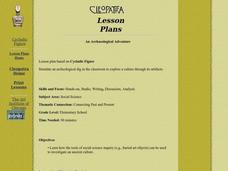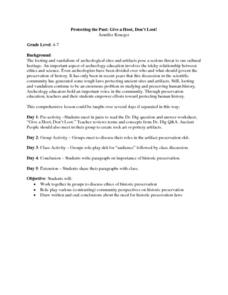Curated OER
Stories of the Wrights' Flight
Students examine and compare primary and secondary source accounts of the Wright brothers' first flights on December 17, 1903.
Curated OER
Money Talks
Students move from fact finding to interpretation as they examine paper money from the time of the American Revolution. In the final exercise, they use the issue dates of the bills to construct a chronology of political changes during...
Curated OER
Pictures Telling Stories
Students see the importance of primary sources in the study of history, but also the limitations of relying only on primary sources of taking the money, as it were, at face value.
Curated OER
Spy on a Spider
Students view slides or live specimens to name and describe the distinguishing features of groups of arthropods, especially spiders and insects. They complete worksheets, observe webs and then search for and record where spiders can be...
Curated OER
Letters from the Japanese American Internment
Students make deductions about life in an internment camp by reading and comparing letters written to Clara Breed. Along the way, they consider the advantages of looking at a historical event from the multiple points of view of...
Curated OER
What a Site!
Fourth graders are introduced to how to properly create a grid site. In groups, they use Cartesian coordinates to establish the boundaries for the grid and photograph the location of artifacts. They exchange their photos with another...
Curated OER
An Archaeological Adventure
Students simulate an archeological dig in the classroom to explore a culture through its artifacts.
Curated OER
Trash...it really piles up!
Students investigate a contemporary "midden" by analyzing trash collected from various sources and determining life-style choices people make. They see that reducing the amount of waste we generate is helpful to the the environment.
Curated OER
Protecting the Past: Give a Hoot, Don't Loot
Students discuss the looting and vandalism of various archeological sites. In pairs, they read and complete a worksheet and review their answers as a class. In groups, they role play a artifact preservation skit and perform it to their...
Curated OER
Pottery, Porcelain, And Posterity
Young scholars research and discuss the various ceramic techniques foudn throughout China's history using primary source documents and internet resources. This lesson emphasizes small learning groups.
Curated OER
Teaching About Trade in the Ancient Mediterranean
Sixth graders examine the trade routes in the Mediterranean of the Ancient world. In groups, they view slides of artifacts while answering questions on a worksheet. After watching a video, they discuss how each object was found and...
Louisiana Department of Education
Louisiana Doe: Louisiana Believes: English Language Arts: Grade 6: If Stones Could Speak
Sixth graders will explore history and will learn that archaeologists, like detectives, work to piece together the past through investigation. Archaeological research provides us with stories of human history that help us understand the...
PBS
Pbs Teachers: Scientific American: Science Safari: The First People
Emulate the work of archaeologists in South Africa attempting to solve the riddles of human evolution by inferring a person's height from the length of one bone. Identify and communicate present-day rituals through ancient art techniques.
Yale University
Ynhti: An Excursion to Cities of Mysterious Pasts
A learning unit which explores both the modern city of Mexico City and the cities that lie hidden underneath: Tenochyiylan and Teotihuacan.














